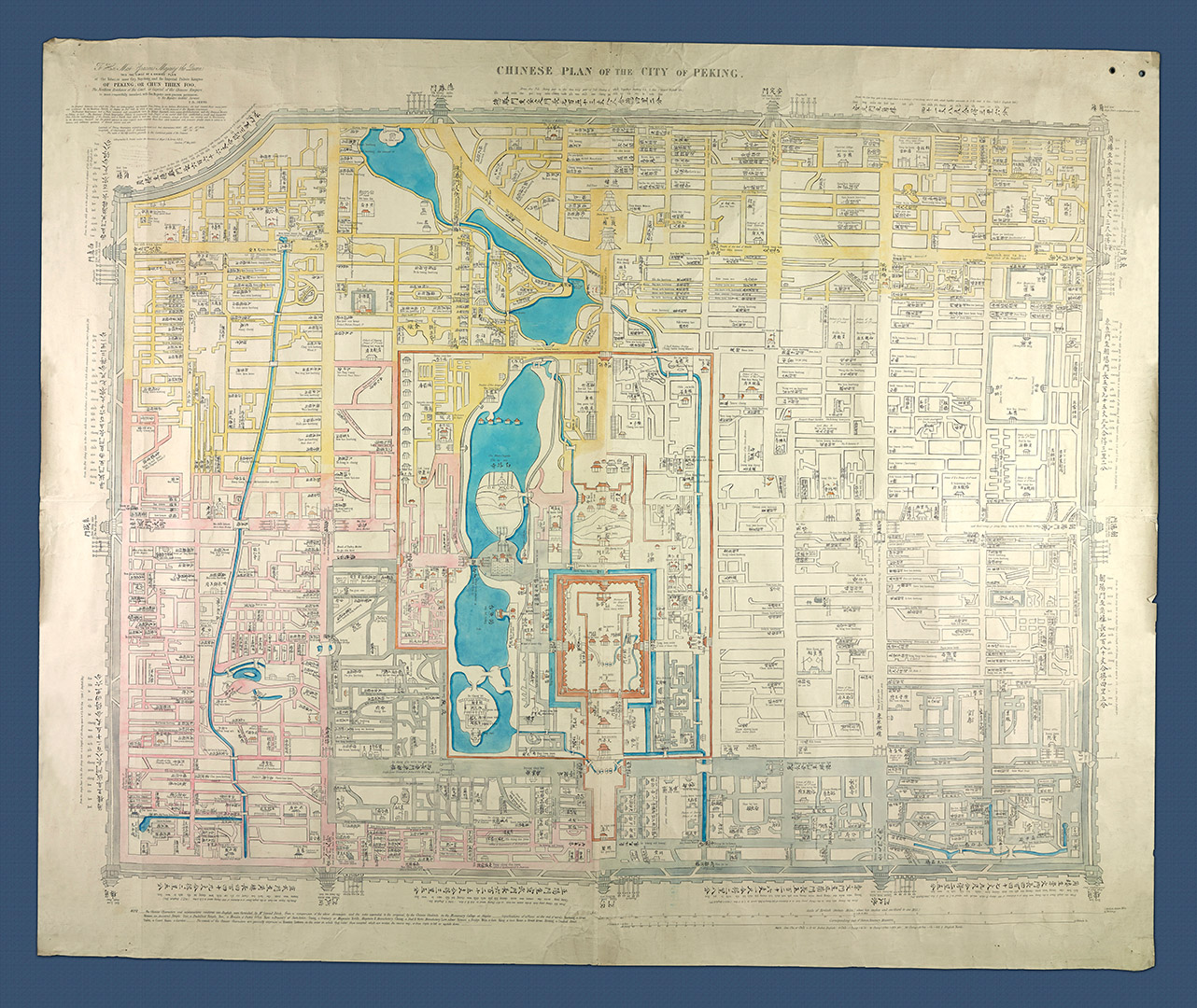C100 - A Plan of the city of Peking (Beijing)
Peking and the Forbiden City in 1843 This beautiful Plan of the city is remarkable for it's Chinese and English text. It is hand-colored and shows the Tatar, or Inner City Nuyching and the Imperial Palace Kingtoo of Peking, or Chun Thein Foo (Beijing), as it was known in 1843. This was the Northern residence of the Court, or Capital of the Chinese Empire.
- 1843
- Major Thomas Best Jervis (publisher), Samuel Birch (translations)
- h41" x w48.5"
- L
The Plan seen here was one of several surveys put together by the British, after the outbreak of the first Opium War in China (3 November 1839 to 29 August 1842), when it was evident that little was really known about the region in a Europe which was already greedy for trade Imperialistic opportunities.
The plan's legend on the top right explains in full it origins. It is one of the most detailed and accurate plans of the old city, still accurate today over 165 years later. As with many other cartographic works the plan is an amalgamation of previous works, in this case four:
A Plan brought from Peking from an Italian Missionary who had recently returned from Peking possibly Gaubil;
An early (18th century) French plan of 1758 by the eminent French geographers Delisle and Pingre, based on information provided by Jesuit missionaries;
A Russian plan of the city in 1812 completed by Father Hyacinth
A contemporary wood-cut brought from China by the missionary M.Gutzlaff.
The legend states that the plan provided by the Italian Missionary (possibly Gaubil) was purchased by Sir Woodbine Parish, who was at the time Chief Commissioner in Naples, in November of 1842. The plan was subsequently sent to the Royal Geographic Society, who made it known to the then Foreign Secretary Lord Aberdeen, for use in the event of a future attack on the city.
The British, by the mid 18th century had already established the foundations of Empire through the all-powerful Honourable East India Trading Company whose primary overseas office was based in Bombay, India. Major Thomas Best Jervis, a military engineer, who is responsible for the publication of the Plan on behalf of the British Government had worked on the survey of India, and was, a one point, appointed acting Surveyor General of India.
Perhaps the most enduring and relevant feature of this beautiful plan is that all of the text appears both in Chinese and in English. The translations were done by Samuel Birch, a leading Egyptologist and antiquarian, who in 1836 had been appointed to the Antiquarian department at the British Museum on account of his knowledge of Chinese. Chinese distrust of foreign missionaries at the time may be well understood when reading the writings of the missionary M. Guzlaff who was quick to report back deficiencies in Chinese defences as recounted in The Gentleman Magazine of London in 1835 in an article which quotes him as saying of China; 'The Great Wall, the Tartar frontier is wholly inadequate to the defence of the country against modern tactics; on the east it can be easily assailed by any petty maritime power; it has everywhere excellent harbours, and ships may go a considerable distance up some rivers without any fear of meeting a force to repel them.'.
The Gazette Magazine was prompted to comment that; 'We believe neither of these statements to be correct: but even were they so, we ask, is it the part of a man who professes to be a minister of the Gospel of Peace, and a Christian missionary, under the cloak of history to make himself the mere pioneer of war, and the harbinger of an invading force? We think not.'
The Plan itself measures w115cm x h96cm and is made up of 4 sheets joined together. The original is a Lithograph print and was highly regarded for being a celebration of both Chinese science and art which is evident in the both the layout of the plan as well as its presentation. Scales of corresponding distances; Chinese Li (or a Lea’ as the plan labels it), along with other units and British statute miles and furlongs are given with distances between locations clearly marked along with historical, social, commercial, religious and imperial monuments.
Many of the Hootungs shown are still in existence today even as the city comes to terms with its own modern development although, thankfully, the place of execution is not! It is also worth noting that the plan makes use of vibrant color to indicate different areas or sections of the city which lends a great deal of artistic merit to the overall picture. Also of note is the translation of key works between Chinese and English provided by Samuel Birch.
- A Plan of the city of Peking (Beijing)


